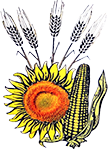Perspectives of Exploiting Wild Species/Local Landraces For Cereals Improvement
in the Context of The Actual Changing Climate
Elena-Laura Conțescu, Matilda Ciucă, Daniel Cristina, Alexandru Dumitru, Elena Partal, Alina Gabriela Turcu
Institutul Național de Cercetare Dezvoltare Agricolă Fundulea
Keywords: adaptability, cereals, breeding, wild species.
Abstract: Challenges such as global warming and increased demand for agricultural products, due to population growth, have determined the urgent need for new genotypes with improved adaptability to new environmental conditions, high yield and superior quality traits.
Intense selection used for the breeding of the actual crops conduced to a narrow bottleneck which can be widened only by using new genetic resources, like wild relatives of crops and local landraces, who are available in gene banks/botanical gardens/spontaneous vegetation.
Today, with the available tools of genomics, genetic variation of wild species could be used for improving the yield, nutritional quality, plant architecture, adaptability to climate changes and other important traits by providing new alleles/genes for resistance to biotic (fungi, viruses, insects, etc.) and abiotic stresses (high/low temperatures, drought and heat, salinity, etc.).
The aim of our study is to exploit cereals and wild species genetic diversity in breeding programs and to identify solutions that will generate new germplasm with avoidance abilities and high adaptive potential to cope with future predicted adverse environmental factors. Using wild species to increase the genetic base of cultivated cereals will involve: improving actual collections with new wild species varieties, determining the degree of polyploidy in the current collection of Hordeum bulbosum and expanding the allelic diversity, including through intergeneric hybridizations, by transferring genes for rhizomatous root in cultivated varieties from Leymus and Thinopyrum species to significantly increase soil carbon sequestration potential and contribute to climate change mitigation.
For this reason, wild species and local populations can play a key role in the future of agriculture and food security.
